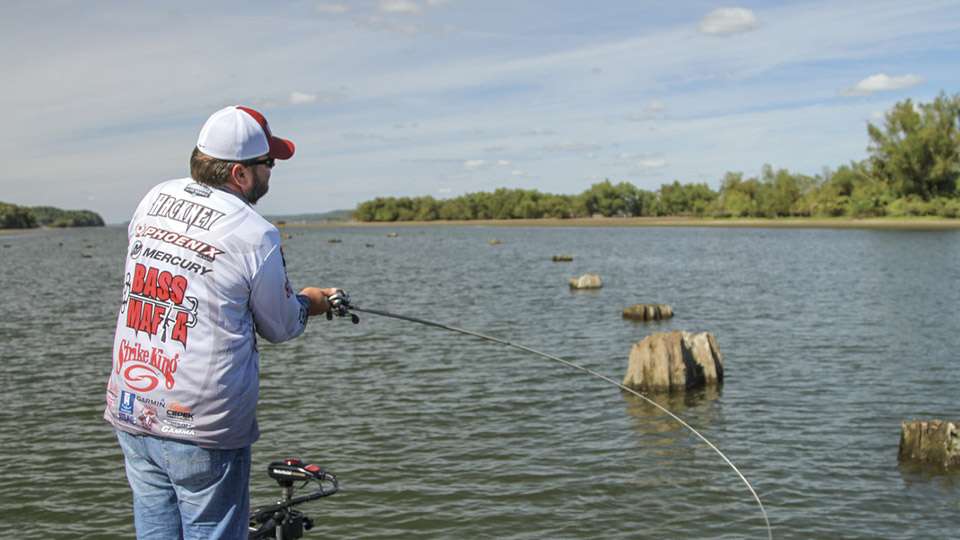
It’s a fact: Sometimes, you have to do things the hard way. But if it means catching bass around natural wood targets, that’s not such a bad deal.
We could fairly include wooden docks in this conversation, but for tighter focus, we’ll stick with the locally grown stuff — specifically, laydowns, standing timber and stumps. There are lots of details among these bass magnets, so let’s go with the why, where and how, as explained by a trio of wood-savvy Bassmaster Elite Series pros.
For starters, Chris Zaldain bases his general affinity for wood targets on their foundational value. Bass generally think with their stomachs, so there you go.
“Wood provides a very good start to an ecosystem,” Zaldain said. “Wood provides cover for every living organism underneath the water’s surface, from phytoplankton and zooplankton, to algae and various [forage], including crawfish and my favorites — bluegill and crappie.
“Think about it: Wood was once a living thing, and living things tend to live around life. You can’t say that about rocks or docks. Living organisms attract other living organisms, starting at the bottom of the food chain and working all the way up to the apex predator, which is a bass.”
Keith Combs agrees and notes that the obvious advantages of shade and cover benefit bass at both ends of their life cycle. Shallow wood provides spawners not only requisite hard bottom, but also an instant fry nursery.
When it’s right
Most agree that wood, in some form, can play year-round, but seasonality helps you dial in the more likely options. Zaldain notes that the extremes of winter and summer find deeper, vertical wood — often main-lake areas — more productive, while spring and fall bring the shallow cover into focus. Exceptions exist, but this rule of thumb will keep you in the ballpark.
As Greg Hackney points out, across the calendar, all types of wood habitat remain relevant in rivers and natural lakes, while reservoirs find the shallow stuff highlighted mostly during the spring spawning migrations. From postspawn through winter, it’s largely an offshore deal.
For some, wood’s a no-brainer, top-tier go-to. Others consider it a functional option always worth a look. Personal preference guides much of this, but consider this Elite-level insight when sizing up your wood-fishing opportunities.
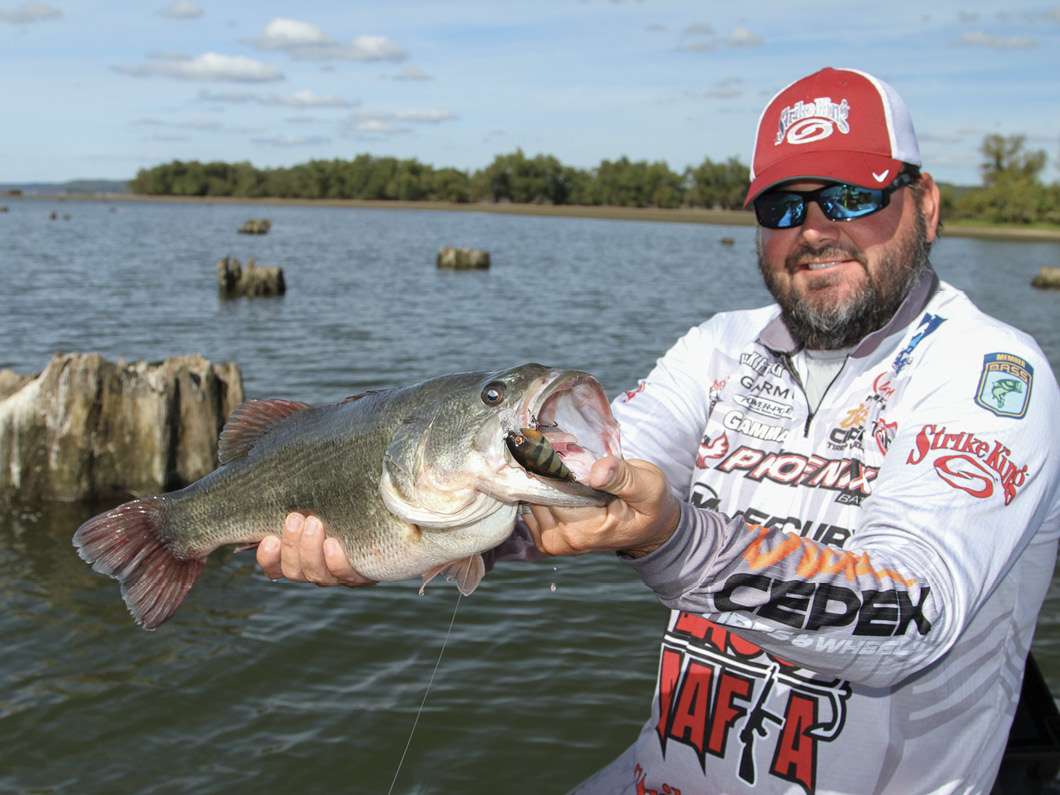
On the bank
You’re unlikely to catch every fish you hook in a laydown, but Combs knows the potential reward justifies the risk. Nevertheless, not every tree on the bank merits your time/attention.
Isolated targets, whether secluded by drawdowns or natural placement, definitely exude bass appeal but, as Combs notes, everybody knows this. Arming himself with a spinnerbait, crankbait, flipping rig and shaky head, he fishes what others ignore.
“I look for something that appears to be too shallow to fish, but it may have a channel adjacent to it,” Combs said. “Those places replenish so well, I can catch a fish there in the morning and come back in the afternoon and catch another one.
“I also look for smaller stuff. If you have a giant willow tree, everybody is going to fish it, but if you have a little blow-in, it may not get fished all the time.”
Zaldain said he’ll fish any oak or cedar laydown with the right positioning, but he’s partial to Bois D’arc trees — a member of the mulberry family, also known as Bodark, Hedge Apple or Osage Orange for its characteristic yellow-green fruit. The tree’s bushy form offers dense habitat when submerged, thereby making it a prime target for spring jig flipping.
“You may have a bank where erosion has caused new trees to fall over, but if there are a lot of green leaves on them, I’ll skip over these and target the really old laydowns,” Zaldain said. “I like the ones that already have the bark knocked off of them. The fish use those same laydowns year after year in the spring and the fall, in and out of transition.
“I’ll use a good old 1/2-ounce black/blue or green pumpkin flipping jig with a chunk trailer, because if that fish is there, it’s there to feed. I want something that’s appealing to the fish, but something with a good hookup-to-land ratio.”
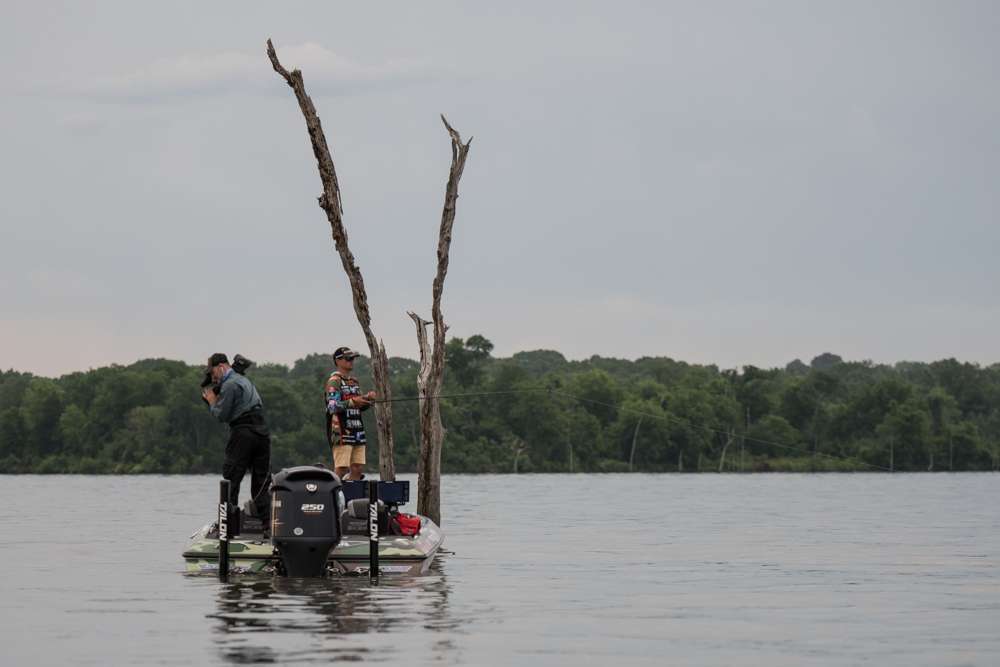
Standing tall
When summer or winter has him exploring offshore timber, Zaldain favors cedars for their generally tall form and upward-growing branches. As far as specific tree form, he wants the piece of cover to offer fish something attractive, but he’s far more concerned with positioning.
“The contour on which the tree is lying is most important to me,” he said. “You go to a lake where there are trees everywhere — whether it’s cypress trees on the bank or cedar trees out in the middle — I’m always looking at my LakeMaster maps to find out where those trees are in relation to those contour lines.
“I’m going to target the channel-swing group of trees, because I know these are the trees closest to deeper water. I’ll target those before I target the random trees on a flat. Bottom variety trumps all because channel swings are highways or stopping spots for bass and baitfish.”
Zaldain’s also watching his Humminbird MEGA 360 for channel-edge laydowns. Lying horizontally or at an angle, depending on the breakoff point, these oddities consistently attract fish.
“I’m going to follow that channel all the way to the back of the creek and fish that last channel swing,” Zaldain said. “A lot of times, that’s where our biggest fish is going to be, either on a larger-than-normal tree or a laydown.”
Also worth noting, in a newly flooded lake with water inundating lush, green trees, a starting point may be hard to determine. Here, Zaldain suggests tuning out the overwhelming volume of new cover and focusing on isolated trees or small clusters.
For any of his standing timber and laydown scenarios, Zaldain likes a 1/2-ounce Santone flipping jig with a chunk trailer or a 6-inch Megabass Magdraft swimbait on a 7/0 TroKar belly-weighted hook. For the latter, it’s all about the big profile and aggressive technique.
“I can really crash that swimbait into those trees and not get snagged,” Zaldain said. “It’s basically an oversized spinnerbait. That jig is for when I really want to pick apart isolated trees. I like a chunk trailer because it glides as it falls. I don’t want a lot of appendages; I want to feel around those trees.”
Combs views standing timber as an often-underutilized habitat, but one with liabilities. His strategy: balance opportunity with time management.
“Most people show up to a lake and they’re headed to the bank because they want to get bit quickly,” Combs said. “If a guy will spend some time trying to locate some offshore timber, he can have it all to himself. The downside is that you can look for days and not find fish in offshore timber.
“There are a few things you can do to narrow the search, but even with [modern electronics], it’s hard to locate them; they just roam through those trees in big schools. They’re not very reliable.”
The key, Combs said, is finding something unique. Most lakes with standing timber have a lot, so immediately whittling down the mass improves efficiency. Timber lines off bluff ends, for example, find fish-friendly habitat along natural travel lanes. Lacking such macro-level clues, he’ll tighten his scrutiny.
“I want to look for trees that are different,” he said. “For example, on Toledo Bend, you may have some trees that are a lot bigger than the other ones; that’s a dead giveaway. I’ve seen the big, gnarly stuff be the preference, or different types of timber.
“There are times when a lake may have three or four types of trees in it, but [bass] want to get on one type of tree. When the Elite Series was on Lake Travis [in 2018], there was a lot of submerged timber offshore, but those fish were in old willow trees.”
Preferring those sunny, calm days when fish want to suspend over treetops, Combs likes burning a Strike King Series 5. When that bite fizzles, he’ll clean up with a Texas-rigged Strike King Recon or Big Thumper worm.
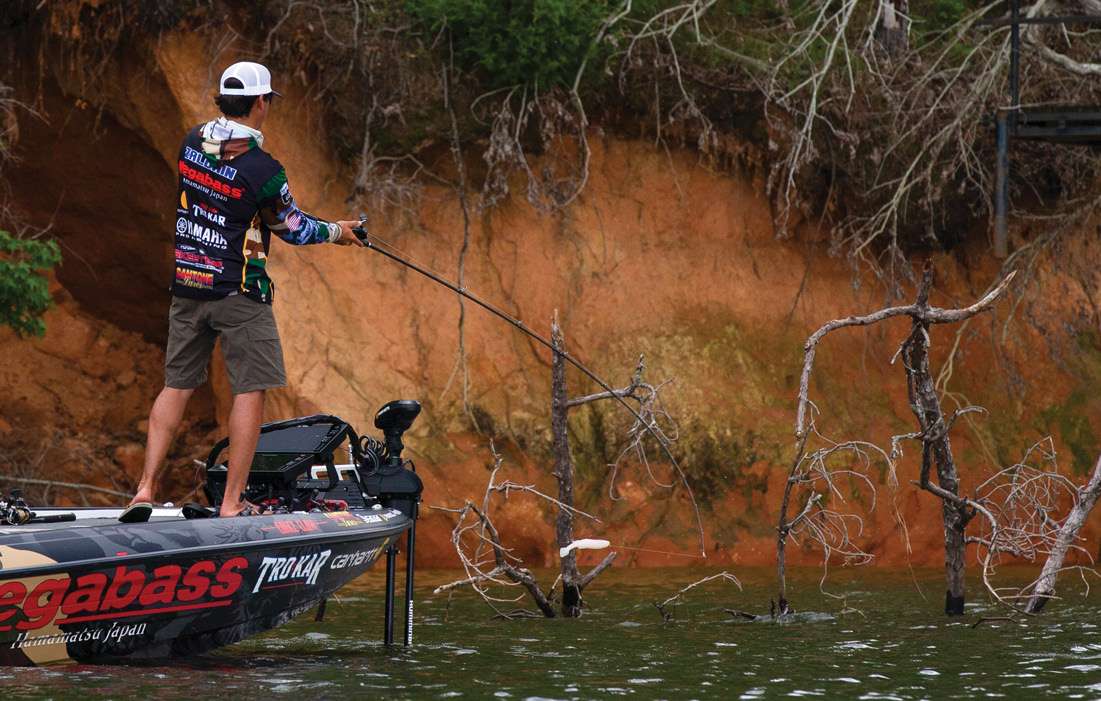
Don’t get stumped
Hackney looks for two main stump scenarios, based on the water body. On a river or natural lake, he looks to shallow stumps for unseen spawners.
“Stumps make it easy to target [spawning] fish you can’t see, because they like those root wads, especially in older lakes,” Hackney said. “When those fish first move up, before they start spawning, I’ll use a moving bait, like a Strike King Thunder Cricket, because they’re really aggressive.
“Once they lock down, I’ll pitch a Texas-rigged Strike King Rodent, which doesn’t have much action. When the water warms, I want more action, so I’ll go to a Strike King Game Hawg or Rage Bug.”
On a reservoir, Hackney’s looking for an isolated stump on a ledge. Particularly on older reservoirs where much of the remnant wood has eroded and scattered, a solitary piece of structure will have plenty of company. Deflecting crankbaits or dragging jigs and Texas rigs typically earns the bite.
“I would rather fish stumps on a drop than man-made brushpiles; man-made cover tends to spread them out,” Hackney said. “Fifty fish will get on a stump, but 50 fish won’t get on a brushpile.”
Also fond of those channel-edge stumps, Zaldain said targeted casts that make contact with the wood are just as important here as with semivisible shallow targets. His Humminbird MEGA 360 helps keep his presentations tight and on target.
Similarly, Combs calls stumps the truest example of a year-round wood target. While he fishes the seasonally appropriate depth, he has a handful of Sam Rayburn sweet spots in 10 to 12 feet that he’d confidently fish any month of the year.
“Brushpiles get a lot of attention, but I have most of these to myself,” Combs said. “If I have time on my hands, idling in and out of an area, I’m watching my side imaging and I’ll mark [isolated stumps]. I won’t even make a cast until tournament day because the fish on these stumps are biters.
“The main thing is isolation. You may have a big ridge or a flat with two or three stumps on it, and no matter the conditions, you could find them. You’re only talking about a handful of fish, but they’re key fish.”
After cranking a stump, Combs will flip a Strike King Structure Jig with a Rage Craw to the exposed roots. If they still need a little convincing, the shaky head usually does the trick.
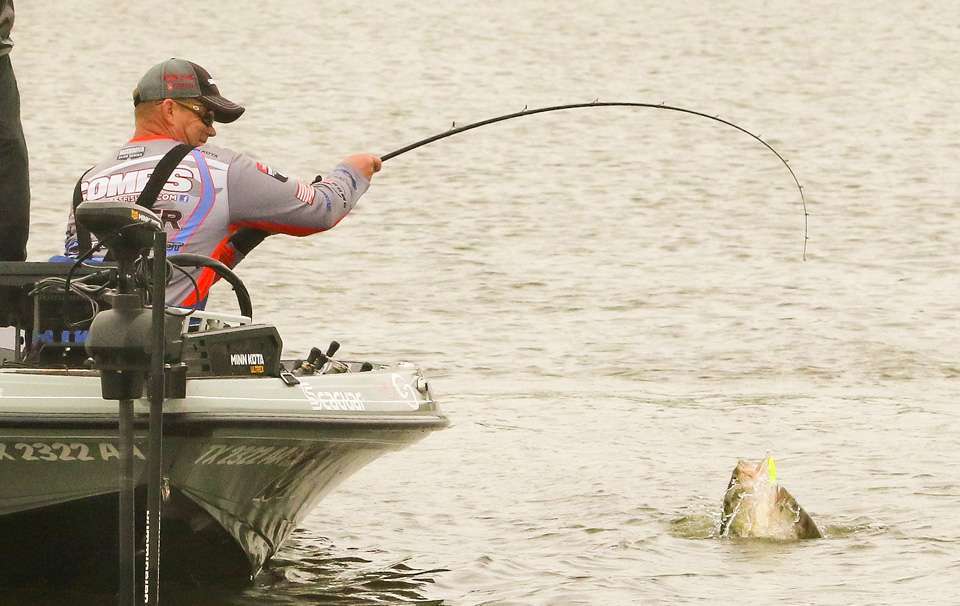
The snag is a drag
Sometimes, the wood bites better than the fish, but that’s part of the game. Combs minimizes his frustrations by first considering his presentation angles. Tide, wind, lake current — don’t leave the retrieve to chance.
“If you’re fishing a laydown with bark on it, if you try to run something down with the grain of that tree, you’re probably going to get hung,” Combs said. “Cast more across it and try to bring your bait over the top of it.
“Also, go light on your baits. If you’re getting hung with a 1/2-ounce jig, switch over to a 3/8- or 1/4-ounce. A lot of times, you’ll get the same bites; you just won’t ever get hung up. It just takes a little longer to get down to the bottom.”
Zaldain’s advice: Accuracy plus forethought prevents regret.
“When I pull up to standing timber, a laydown or whatever it is, on that first cast, I don’t want to screw up the next sequence of casts,” he said. “I want to cast a foot or two off the target and make my way in closer.
“I’ll make a cast with a moving bait to the open water on the right-hand side of the target and then to the left-hand side. I want to be really thorough and work my way to the center. The last thing you want to do is make one cast, snag the [wood], and there goes your chances of catching a 5-plus-pound fish because you just blew up the spot.”
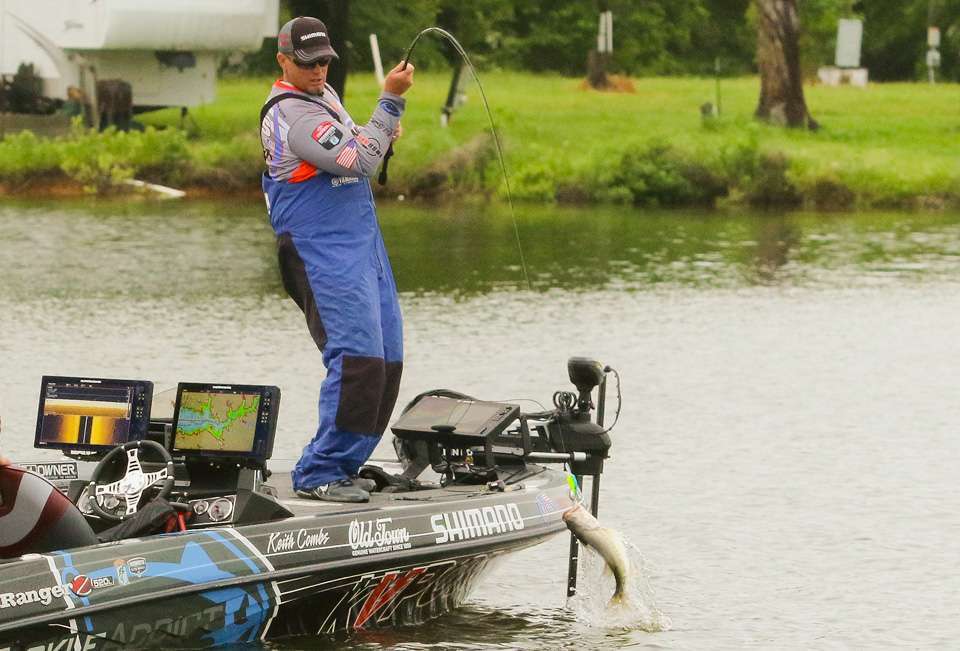
Creative presentations
Wood gets a thorough workout, so showing the fish something different can be the deal-closer. Example: Running three sets of treble hooks through standing timber may sound like the recipe for constant frustration, but Chris Zaldain won’t hesitate to send his Megabass Vision 110 into the submerged forest — but only under electronic supervision.
“You have to be really in-tune with the cast you’re making; you have to be really in-tune with how wide the strides are with the jerkbait,” he said. “It’s a risky way to fish, but the jerkbait has a lot of drawing power, and it will literally pull fish out of 20 feet of water. It’s up to you to keep it far enough away to keep it out of the tree, but close enough to attract that fish.”
Patrick Walters put on a jerkbait clinic with his Century Club victory during the 2020 Toyota Bassmaster Texas Fest benefiting Texas Parks and Wildlife Department. He rotated colors and diving depths based on sky conditions and outfoxed the short-strikers by removing his bait’s center treble and replacing the stock size 6 trebles on the front and rear with size 4 hooks.
Blade Runner: During his 14th-place finish at the Elite tournament on Santee Cooper Lakes, Frank Talley did much of his work by skipping a bladed jig around cypress trees. Time management was his strategy — cover lots of water and hit high-percentage targets.
Light-Headed: Placing 10th on Santee Cooper Lakes, Derek Hudnall bypassed the more common flipping and power fishing techniques in favor of pitching a wacky-rigged Missile Baits 48 worm. Pressured fish often respond to this lighter presentation.
Shake Things Up: Snagging a Texas-rigged worm on shallow wood cover’s a bummer, but Zaldain recalls several instances where patiently wiggling his snared bait enticed a fish to pluck it free. Problem solved, fish caught. Something to consider.
Originally appeared in Bassmaster Magazine 2021.





